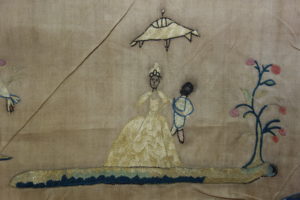By Morwena Stephens, Conservator
This large embroidered wall-hanging (2.5 x 1.75m) is one of a pair accessioned by RAMM in 1957, depicting religious images, animals, flowers and secular scenes. It has been selected for display in the 2022 exhibition In Plain Sight: Transatlantic slavery and Devon. It dates from around 1750 and is associated with Combesatchfield House, which bordered the Killerton Estate.
This textile has been selected as it depicts the lifestyle of wealthy people, with sailing ships suggesting trade, and most importantly there is a black servant holding a parasol above a richly dressed woman. Fashionable portraits of the 18th century often included black servants to demonstrate the wealth and status of their mistress or master. Unfortunately, the black servant’s left leg is unfinished (as is a bird’s head above). The parasol pole is lost through deterioration of the dark thread.
The plain weave linen ground is embroidered with distinct motifs or scenes, including a beehive, deer and angels in clouds, worked in wool and silk, and is lined with linen. The embroidery has been hung, possibly on a frame as there are rust stained tack holes along the top and bottom edges, in a house or possibly a church for years, and the damage is consistent with this. The linen has darkened through exposure to light and UV radiation. This has embrittled the fibres causing splits to form, especially towards the top where more light would have fallen. Embroidery threads are brittle, due to light and UV, and to the iron mordants, which would have been used to dye the dark brown threads. There was a lot of ingrained soiling, heaviest towards the bottom of the panel, and stains from mould associated with a damp Westcountry historic building environment.

The hanging was cleaned using controlled vacuum suction, and conservation sponges to remove the ingrained sooty black soiling. This brightened the embroidery significantly. Creases were removed using humidification controlled by ‘Goretex’ before splits and holes were supported onto dyed cotton patches with conservation stitching. The technical team are building a case to show the lower part of the hanging while supporting the fragile top section on an acid-free roller underneath. Joy Gregory, the artist making work for the exhibition, has been inspired by this hanging to make a textile piece for the show.
This content is viewable by members only. Login or sign up to get access.

